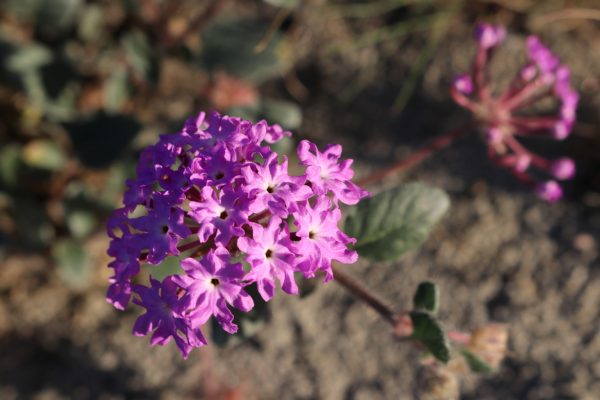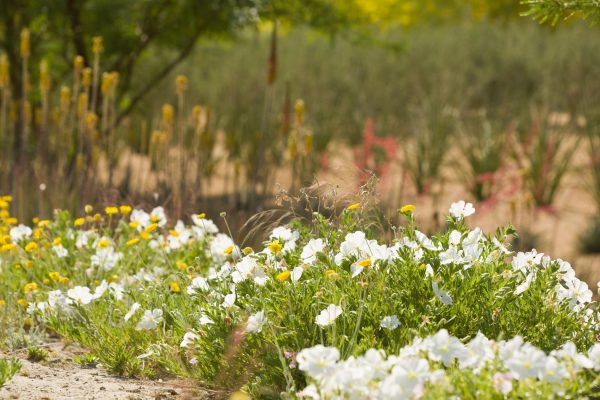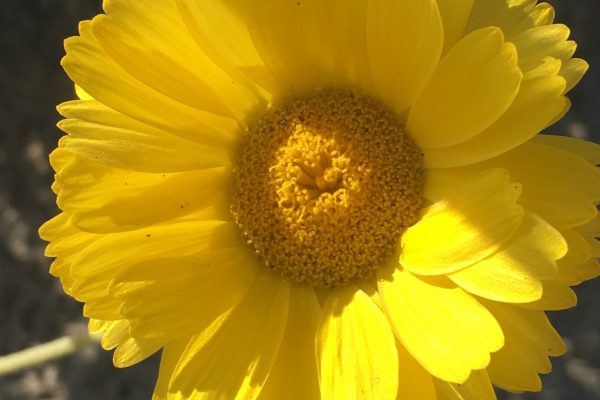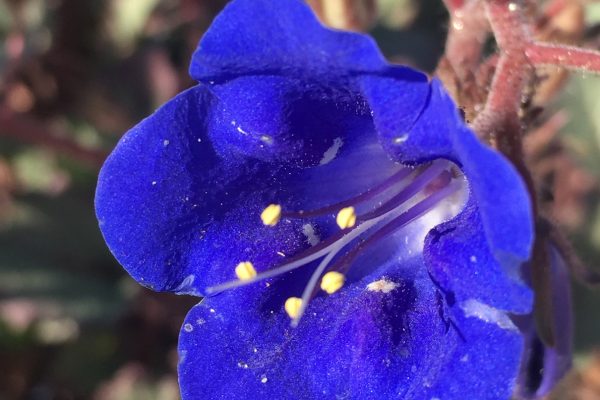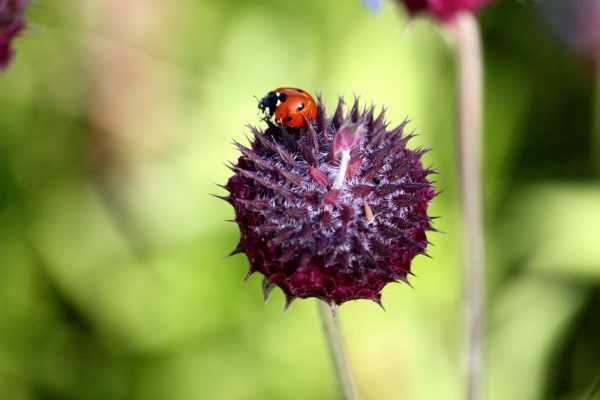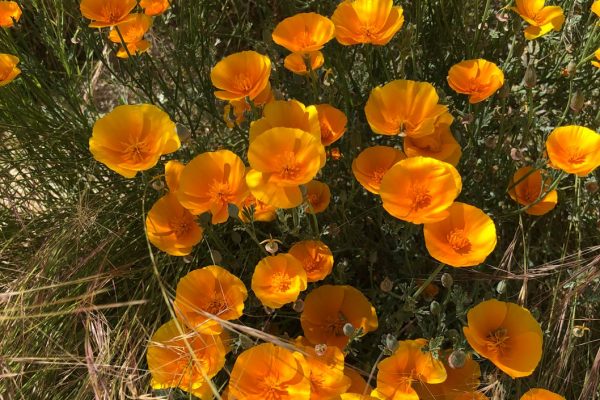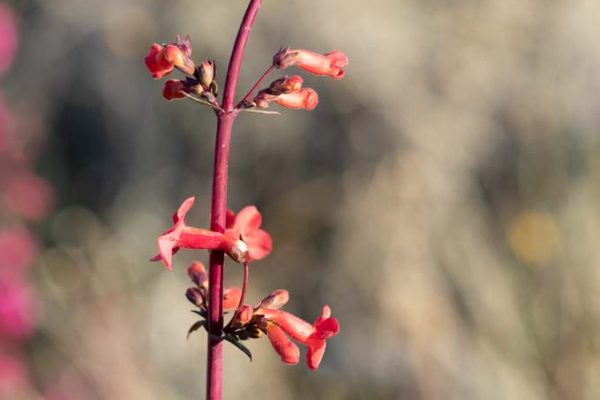
Found mostly in the Mojave Desert, Desert Penstemon is a robust, blooming plant that never fails to impress. It flowers mainly in reddish pink tones, but cultivated varieties of many colors are in nurseries today. Hummingbirds are attracted to its blooms, and songbirds follow to collect seed. The dried stalks and seed heads rise above the leaf base that can turn to lighter yellows later in season. The stalks can be cut off or left through fall and winter to add interest.
Starting in 2018, Penstemon plants were added to the wildflower field. Originals were transplanted from pots to get them started. They were left to disperse seed, from which additional plants have grown.
The Wildflower Field
The wildflower field at Sunnylands is overseeded annually with native wildflowers and bunch grasses. This provides visitors with a view of the larger cyclical bloom cycles that we have in the desert. Starting in February, a variety of native species and bunch grasses begin emerging. Each year the vegetation varies slightly, depending on which seed dominates the space. The field can range in color from purples to oranges, whites, and pinks, with a variety of combinations. We cannot guarantee that all wildflowers will be present each year.

One of the most familiar desert wildflowers is the Sand Verbena. It is very successful in disturbed areas as well as in dunes and other desert spaces. If heavy rains occur in the months leading up to the bloom season, it is likely that Sand Verbena will dominate the fields and sandy lots throughout the desert. Each plant can expand up to 3 feet and in good seasons create a purple carpet across sandy fields. It is quite often intermixed with Dune Primrose, which is also in the wildflower field.
The name Abronia means “graceful” in Greek and describes the delicate dome-shaped flower clusters. The Abronia villosa will start blooming in spring and at high elevations may continue into June. Sometimes it can begin blooming as early as November.
Western North America is home to all 25 known species of Sand Verbena that range from coastal to desert sand dune ecosystems, including washes and coastal dunes. They can grow in other habitats, but these are primary.
The Wildflower Field
The wildflower field at Sunnylands is overseeded annually with native wildflowers and bunch grasses. This provides visitors with a view of the larger cyclical bloom cycles that we have in the desert. Starting in February, a variety of native species and bunch grasses begin emerging. Each year the vegetation varies slightly, depending on which seed dominates the space. The field can range in color from purples to oranges, whites, and pinks, with a variety of combinations. We cannot guarantee that all wildflowers will be present each year.

Desert Primrose, like the purple Sand Verbena with which it shares its dunes, is one of the more identifiable wildflowers of the Colorado Desert (the desert that encompasses the Coachella Valley). Desert Primrose comes up in spring to add soft, white cup-shaped blooms among the clusters of purple verbena. It can be surprising to see such a delicate looking flower in the desert’s harsh climate.
The blooms open at night and are gone by the following midday. During this period, it is pollinated by the White-lined Sphinx Moth (Hyles lineata). These moths have a unique flight pattern that resembles hummingbirds. In fact, they are sometimes confused with hummingbirds. Once pollinated, the Primrose will set seed. When it has completed its cycle, the stems will grow up and as they dry out, their tips will meet at the top, forming what looks like a birdcage. This has given the plant its additional nickname, Birdcage.
The Wildflower Field
The wildflower field at Sunnylands is overseeded annually with native wildflowers and bunch grasses. This provides visitors with a view of the larger cyclical bloom cycles that we have in the desert. Starting in February, a variety of native species and bunch grasses begin emerging. Each year the vegetation varies slightly, depending on which seed dominates the space. The field can range in color from purples to oranges, whites, and pinks, with a variety of combinations. We cannot guarantee that all wildflowers will be present each year.

Desert Marigold is a prolific bloomer in the wildflower field. At least one of the plants appears to be blooming at all times. The largest blooming occurs in spring and summer. Desert Marigold’s common name is slightly misleading as it is not related to what is now categorized as true marigolds, those in the genus Tegetes.
Desert Marigold forms small clumps of bright green leaves and sends stalks up above the clump that produce bright yellow daisy-like blooms. When planted in mass, it provides a gorgeous groundcover. There is more than one species of Baileya, but the species in the wildflower field is multiradiata, which means its blooms are arranged symmetrically. This arrangement creates the appearance of the blooms being perfectly round.
This is a North American native that is found in northern Mexico in the states of Sonora, Chihuahua, Coahuila, Durango, and Aguascalientes. In the United States it is native to California, Arizona, Nevada, Utah, New Mexico, and Texas.
The Wildflower Field
The wildflower field at Sunnylands is overseeded annually with native wildflowers and bunch grasses. This provides visitors with a view of the larger cyclical bloom cycles that we have in the desert. Starting in February, a variety of native species and bunch grasses begin emerging. Each year the vegetation varies slightly, depending on which seed dominates the space. The field can range in color from purples to oranges, whites, and pinks, with a variety of combinations. We cannot guarantee that all wildflowers will be present each year.

Desert Canterbury Bells was added to the seed mix in 2013, the year after the gardens were installed. A visitor favorite, it has a tall stalk and a bloom that curves away from the stem like a bright blue bell. As a desert annual, it appears between February and April during the Spring bloom. It flowers, disperses seeds, and dies. The seeds that it disperses can either bloom the following year or, in a unique pattern of desert wildflowers, can wait several years for the perfect moment and conditions to germinate. With a preference for good drainage, sun, and dry weather, the wildflower field is a perfect location for the Desert Canterbury Bells.
Its range is within the borders of California’s Mojave and Sonoran deserts, though it is heavily cultivated as an ornamental outside this range.
The Wildflower Field
The wildflower field at Sunnylands is overseeded annually with native wildflowers and bunch grasses. This provides visitors with a view of the larger cyclical bloom cycles that we have in the desert. Starting in February, a variety of native species and bunch grasses begin emerging. Each year the vegetation varies slightly, depending on which seed dominates the space. The field can range in color from purples to oranges, whites, and pinks, with a variety of combinations. We cannot guarantee that all wildflowers will be present each year.

Chia has been heavily cultivated and commercialized to produce chia seed for the food market and, of course, the ever popular Chia Pet™. It is touted for its health and energy boosting characteristics. It is not an easy wildflower to find naturally growing outside of boom wildflower years, and would be easily overlooked by casual hikers who are unaware of the significant lore surrounding it. It is an important food source for wildlife and humans.
The Chia are small, with flat, frilly leaves that spread out from the base. As a member of the mint family, the Chia stalk has four flat sides. In a crosscutting, the stalk would appear as a square. Blooms are round bracts with flower clusters that are distributed up the stalk.
It is found in California, Nevada, Utah, Arizona, and New Mexico in the United States. In Mexico, it’s found in Sonora and Baja California.
The Wildflower Field
The wildflower field at Sunnylands is overseeded annually with native wildflowers and bunch grasses. This provides visitors with a view of the larger cyclical bloom cycles that we have in the desert. Starting in February, a variety of native species and bunch grasses begin emerging. Each year the vegetation varies slightly, depending on which seed dominates the space. The field can range in color from purples to oranges, whites, and pinks, with a variety of combinations. We cannot guarantee that all wildflowers will be present each year.

The California Poppy is the official state flower of California. The state’s renowned author, John Steinbeck, described it as evoking the color of cream that would rise from molten gold, if that were possible. It is indeed beautiful to behold in mass, but there’s no challenge in that. A hiker fortunate enough to come across a single poppy on a California sand dune must think, “Eureka! I have found one.”
In the wildflower field, the flower adds a pop of creamy orange that plays well off the bright yellows of the Brittle Bush and the Desert Marigold. According to Matt Ritter, author of California Plant – A Guide to Our Iconic Flora, the first specimen collected for western recordings was during a Russian exploration and is housed in Saint Petersburg, Russia.
When the California Poppy blooms, it sends up a sepal, which is a green, cone-shaped protective shell. The flower pushes through the sepal when it blooms. A fruit that dries follows the bloom. When it’s ready to disperse seeds, it does so forcibly and can make a popping sound. Hence the name, Poppy.
Wildlflower Field
The wildflower field at Sunnylands is overseeded annually with native wildflowers and bunch grasses. This provides visitors with a view of the larger cyclical bloom cycles that we have in the desert. Starting in February, a variety of native species and bunch grasses begin emerging. Each year the vegetation varies slightly, depending on which seed dominates the space. The field can range in color from purples to oranges, whites, and pinks, with a variety of combinations. We cannot guarantee that all wildflowers will be present each year.

